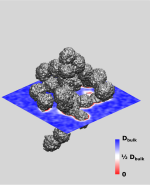HPC User Report from B. Becit (Professorship of Theoretical Chemistry)
MD Simulations of Mesoporous Silica Formation
The agglomeration of silica nanoparticles in aqueous solution is investigated upon association of SiO2/Si(OH)4 core/shell particles. Supplying multiple colloidal particles, our simulations rationalize the formation of hollow but stabile mesoporous silica structures hosting extended pores.
Motivation and problem definition
Mesoporous silica nanoparticles (MSNs) has gained significant attention since its large surface area make them ideal to host molecules, to be used as biocatalysts and drug/gene delivery vehicles , and also for various biomimetic processes. Despite broad interest, our in-depth understanding is rather limited. Understanding/controlling interfacial interactions, association and aggregation is vital for the goal-oriented use of colloidal silica particles. Aim of this work is to outline a MD approach to colloidal silica association, ripening reactions and mesoporous precipitate formation. Inherent time-length scale was handled with Kawska-Zahn approach originally developed for studying crystal nucleation from solution.
Methods and codes
 All MD simulations were performed with LAMMPS software. Free energy for the interaction of two identical colloidal silica nanoparticles were calculated with Collective Variable (colvar) module of LAMMPS. For necessary pre/post processing, WHAM code, implementations on LAMMPS were employed. Due to size of the simulation box and requirements of carried calculations, parallel computing was highly necessary throughout the work.
All MD simulations were performed with LAMMPS software. Free energy for the interaction of two identical colloidal silica nanoparticles were calculated with Collective Variable (colvar) module of LAMMPS. For necessary pre/post processing, WHAM code, implementations on LAMMPS were employed. Due to size of the simulation box and requirements of carried calculations, parallel computing was highly necessary throughout the work.
Results
With this work using RRZE’s HPC system, we successfully modelled characterization of mesoporous silica. By modelling mechanisms of , first, association of two colloid silica and following ripening reactions, our simulation unravel atomic-scale details of nature of cavities/pores formation and surface/interface properties.
Outreach
B. Becit, D. Zahn: Molecular Mechanisms of Mesoporous Silica Formation from Colloidal Silica; in preparation
Researcher’s Bio and Affiliation
Bahanur Becit obtained her bachelor degree in Molecular Biology and Genetics at Bilkent University in Ankara/Turkey, and then her master’s degree in Computational Biology and Bioinformatics at Kadir Has University in Istanbul/Turkey. She is currently a PhD student in the group of Prof. Zahn at Theoretical Chemistry department.
